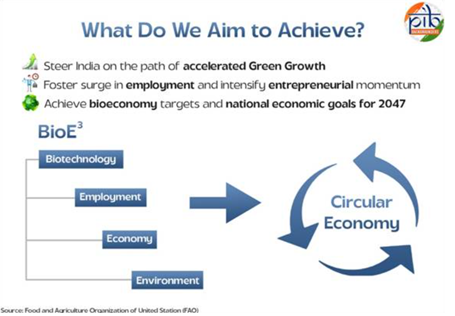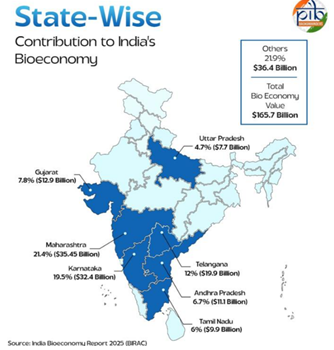

8th September 2025 (12 Topics)
Context:
India’s bioeconomy expanded from USD 10 billion (2014) to USD 165.7 billion (2024), with a target of USD 300 billion by 2030, marking it as one of the fastest-growing in the world.
Biotechnology as a Driver of Sustainable and Inclusive Growth
Introduction
- Bioeconomy is the sustainable use of renewable resources (plants, animals, microorganisms) to produce food, energy, medicines, and industrial products.
- India contributes 25% of GDP through bioeconomy, supported by biotechnology, agriculture, healthcare, and industrial innovations.
- With the BioE³ Policy (2024) and youth-focused initiatives like the BioE³ Challenge, India aims to integrate biotechnology into its economic and environmental strategy.
Key Drivers of India’s Bioeconomy
- BioIndustrial (47% share, USD 78.2 bn)
- Growth led by biofuels, bioplastics, enzymatic applications, biosynthetic chemicals.
- Enabled 20% ethanol blending by 2025 (5 years ahead of target).
- Contributes to circular economy and sustainability.
- BioPharma and BioMedical (35.2% share, USD 58.4 bn)
- India is a global vaccine hub; Serum Institute holds 24% global share (2024).
- Innovation in gene editing, cancer immunotherapy, CAR T-cell therapies, AI-driven diagnostics.
- Expanding MedTech and affordable biologics strengthens healthcare access.
- BioAgri (8.1% share, USD 13.5 bn)
- Driven by GM crops, precision farming, bio-fertilizers, bio-based pesticides.
- Bt cotton success improved productivity and farmer incomes.
- Supports sustainable agriculture and food security.
- BioResearch&BioIT (9.4% share, USD 15.6 bn)
- Includes contract research, bioinformatics, biotech software, clinical trials.
- India emerging as global hub for cost-effective R&D services.
- Enhances drug discovery and data-driven healthcare.
Policy Framework and Institutional Support
- BioE³ Policy (2024): promotes economy, environment, and employment through biomanufacturing.
- 21 BioEnabler facilities set up for startups and SMEs in areas like smart proteins, carbon capture, marine biotechnology.
- Biofoundry Network (2025): first national initiative to support biomanufacturing ecosystem.
- Biotech startup growth: 5,365 (2021) ? 13,000 (2025), developing 800+ products with $600 million in funding.

Climate Change Mitigation and Sustainability
- Bioeconomy reduces GHG emissions, supports bioenergy use, recycling, forest restoration, and sustainable agriculture.
- Achieving 20% ethanol blending saved ?1.44 lakh crore in foreign exchange and substituted 245 LMT crude oil.
- Promotes energy independence, food security, and green growth.
Regional Contribution
- Maharashtra (21.4%), Karnataka (19.5%), Telangana (12%) are top contributors.
- Southern region dominates with 4% share, followed by Western (30.3%), Northern (18.5%), and Eastern (5.8%).
- Regional clusters reflect strong innovation ecosystems in South and West India.
Global Context and Future Outlook
- Global bioeconomy projected to grow from $4 trillion (2020) to $30 trillion (2050) (~12% of world GDP).
- India’s bioeconomy could reach $1.4–2.7 trillion by 2050 (6.5–12% of projected GDP $22 trillion).
- India’s leadership in vaccines, ethanol blending, and bio-manufacturing positions it as a global powerhouse.
Challenges
- Need for stronger regulatory frameworks for biotech and bio-safety.
- Dependence on global collaborations for advanced technologies.
- Skilled workforce gap in synthetic biology, gene editing, and bioinformatics.
- Ensuring equitable farmer benefits from biofuel and agri-bio initiatives.
Way Forward
- Strengthen R&D: Expand Centres of Excellence, promote indigenous biotech innovation.
- Promote Biomanufacturing: Scale up Biofoundry Network to reduce dependence on imports.
- Invest in Human Capital: Biotechnology-focused education, fellowships, and youth engagement.
- Expand Global Partnerships: Collaborate with EU, U.S., and Asia-Pacific on biotech standards and markets.
- Sustainability Integration: Ensure bio-based industries align with climate goals and environmental safeguards.
More Articles


